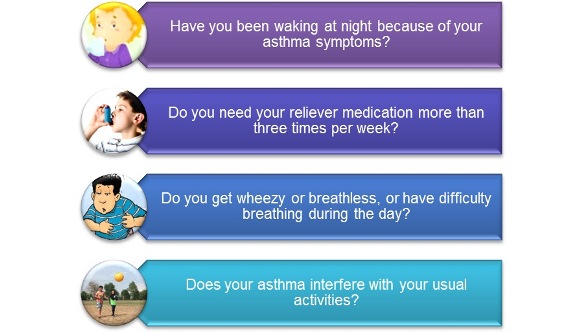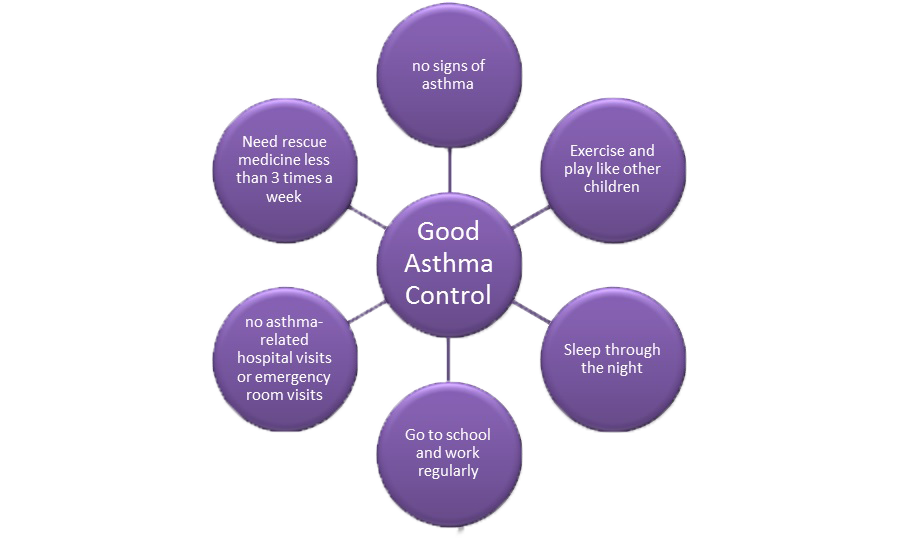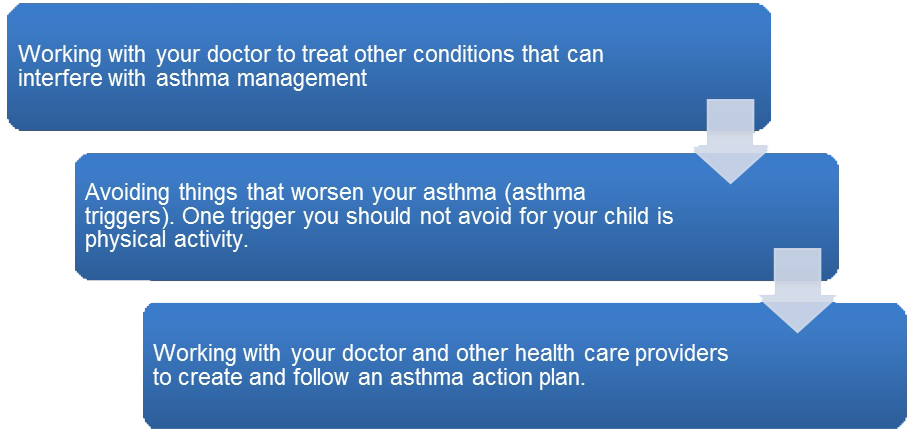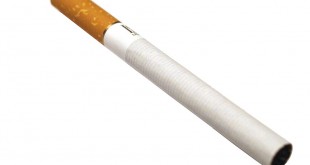Asthma is a long-term disease that has no cure. Today, more children are treated for asthma than ever before. The goal of asthma treatment is to achieve good control, and maintain normal activity levels. Good asthma control will:
- Prevent chronic and troublesome symptoms, such as coughing and shortness of breath
- Reduce your need for quick-relief medicines
- Help you maintain good lung function
- Let you maintain your child’s normal activity level and sleep through the night
- Prevent asthma attacks that could result in an emergency room visit or hospital stay
Assessing Asthma Symptom Control
Asthma symptoms such as wheeze, chest tightness, shortness of breath and cough typically vary in frequency and intensity, and contribute to the burden of asthma for the patient. Poor symptom control is also strongly associated with an increased risk of asthma exacerbations.
Directed questioning is important, as frequency or severity of symptoms that patients regard as unacceptable or bothersome may vary from current recommendations about the goals of asthma treatment, differs from patient to patient.
How do I know if my child’s asthma is well controlled?

If the answer to any of these is yes, your child’s asthma may not be as well controlled as it could be. You as parents need to do something about it.
Child with asthma can stay well and lead normal lives if asthma is controlled.

To control asthma, partner with your doctor to manage your child’s asthma. Children aged 10 or older and younger children who are able should take an active role in their asthma care.
Taking an active role to control your child’s asthma involves:

Asthma symptom control tools
Categorical symptoms control tools: examples include the consensus-based GINA symptom control tool.
Numerical “asthma control’ tools: these tools provide scores and cut points to distinguish different levels of symptom control. These scores may be useful for assessing patient progress. Examples are:
- Asthma Control Test (ACT) with separate for parent and child to complete.The Asthma Control Test (ACT) is a way to help you and your healthcare provider determine if your asthma symptoms are well controlled. If you are 12 years or older, this short test will provide a score that you should share with your healthcare provider to help assess if your asthma symptoms are well controlled.
The Childhood Asthma Control Test (c-ACT) is designed for children 4-11 years old. Take the Childhood Asthma Control Test along with your child and share the results with your child’s healthcare provider.
See link; https://www.nhp.org/provider/asthma/Survey_ACT_child_EN.pdf - Asthma Control Questionnaire (ACQ)These asthma symptom control tools can be used in the asthma outpatient clinic or during inpatient for the assessment of asthma control for the children.
How to take control of your child’s asthma
You can take control of your child’s asthma by knowing what medication he needs to take, how much, and when and how he should take it. Your doctor will work with you to find the right medication and amounts for your child . See link type of medication
Follow these steps to take control today!
- See the doctor regularly to have your child’s asthma reviewed – they can make sure he is are getting the right amount of the right type of medication.
- Make sure you know how to use the inhaler properly. There’s no point having the right medication if you aren’t giving it effectively. It’s thought that the majority of people may not be using their inhalers correctly so the medication does not get to where it is needed. It’s important to check the technique regularly, at least every 6 months.
- Get a personal asthma action plan. This comes from your doctor or nurse and is a set of instructions on how to tell when your child’s asthma is getting worse, and what to do about it.
- Get informed. The more you know about your child’s asthma, the better equipped you are to take control. Talk to your doctor or nurse.
Reference:
- Ministry Of Health Malaysia. Clinical Practise Guideline for Management of Childhood Asthma 2014.
- Global Strategy for Asthma Management and Prevention: Global Initiative for Asthma (GINA) (updated 2012).
| Last Reviewed | : | 5 November 2015 |
| Writer | : | Dr. Noor Hafiza bt. Noordin |
| Accreditor | : | Dr. Norzila bt. Mohamed Zainudin |
 PENDIDIKAN PESAKIT Kementerian Kesihatan Malaysia
PENDIDIKAN PESAKIT Kementerian Kesihatan Malaysia



